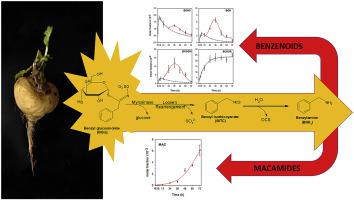当前位置:
X-MOL 学术
›
Phytochemistry
›
论文详情
Our official English website, www.x-mol.net, welcomes your feedback! (Note: you will need to create a separate account there.)
Glucosinolate catabolism during postharvest drying determines the ratio of bioactive macamides to deaminated benzenoids in Lepidium meyenii (maca) root flour
Phytochemistry ( IF 3.8 ) Pub Date : 2020-11-01 , DOI: 10.1016/j.phytochem.2020.112502 Eliana Esparza 1 , Winnie Yi 1 , Fabian Limonchi 1 , Eric G Cosio 1
Phytochemistry ( IF 3.8 ) Pub Date : 2020-11-01 , DOI: 10.1016/j.phytochem.2020.112502 Eliana Esparza 1 , Winnie Yi 1 , Fabian Limonchi 1 , Eric G Cosio 1
Affiliation

|
Postharvest processing of maca (Lepidium meyenii Walp., Brassicaceae), a traditional high-altitude Andean root crop, involves slow field drying prior to milling into flour. The progressive tissue dehydration and release of hydrolytic enzymes and substrates from cellular compartments results in the slow accumulation of free monosaccharides, fatty acids and amino acids. A more complex, and faster, kinetic profile is that of glucosinolate breakdown. A number of reactive transient and stable accumulation products are generated during drying, some of which have noteworthy bioactive properties. Among these are macamides, inhibitors of endocannabinoid neurotransmitter degradation in mammalian nervous systems. They result from the condensation of benzyl amine, a glucosinolate hydrolysis product, with free fatty acids released from lipid hydrolysis. Recent research has focused on developing drying processes under controlled conditions that can modulate the biochemistry of glucosinolate hydrolysis to optimize the content of bioactive compounds in the root flour. Low temperature (35 °C) oven-drying of shredded maca roots under controlled air flow generates benzyl amine as primary accumulation product, accounting for up to 94% of hydrolyzed glucosinolate in the flour. Kinetic evidence suggests that both deaminated benzenoids and macamides are allocated from the benzylamine pool through amine oxidase activity or condensation with free fatty acids, accounting for the remaining hydrolyzed glucosinolate (<5%). These activities determine the allocation to either one of these pathways. Later stages of dehydration result in shifts in the molar ratios of deaminated benzenoids, the accumulation of benzoic acid esters and benzyl alcohol. We propose that these are the result of changes in the rates of the reductive and oxidative half-reactions of endogenous aldehyde dehydrogenases. It is the ratio of benzylamine deamination to amide formation that determines the eventual yields of macamides in relation to benzenoids and their esters in maca flour.
中文翻译:

采后干燥过程中硫代葡萄糖苷的分解代谢决定了 Lepidium meyenii (maca) 根粉中生物活性 macamides 与脱氨基苯类的比例
玛咖 (Lepidium meyenii Walp., Brassicaceae) 是一种传统的高海拔安第斯块根作物,其收获后加工包括在磨成面粉之前缓慢的田间干燥。细胞隔室中水解酶和底物的渐进性组织脱水和释放导致游离单糖、脂肪酸和氨基酸的缓慢积累。更复杂、更快速的动力学曲线是硫代葡萄糖苷分解的动力学曲线。在干燥过程中会产生许多反应性瞬态和稳定的积累产物,其中一些具有显着的生物活性特性。其中包括 macamides,哺乳动物神经系统中内源性大麻素神经递质降解的抑制剂。它们是由硫代葡萄糖苷水解产物苄胺与脂质水解释放的游离脂肪酸缩合而成的。最近的研究重点是在受控条件下开发干燥工艺,以调节硫代葡萄糖苷水解的生物化学,以优化根粉中生物活性化合物的含量。在受控气流下低温 (35 °C) 烘箱干燥切碎的玛咖根会产生苄胺作为主要积累产物,占面粉中水解硫代葡萄糖苷的 94%。动力学证据表明,脱氨基苯类和马酰胺均通过胺氧化酶活性或与游离脂肪酸缩合从苄胺池中分配,占剩余的水解硫代葡萄糖苷 (<5%)。这些活动决定了对这些途径之一的分配。脱水的后期导致脱氨基苯类的摩尔比发生变化,苯甲酸酯和苯甲醇的积累。我们认为这些是内源性醛脱氢酶的还原和氧化半反应速率变化的结果。苯甲胺脱氨基与酰胺形成的比率决定了玛咖粉中玛卡酰胺相对于苯类及其酯的最终产率。
更新日期:2020-11-01
中文翻译:

采后干燥过程中硫代葡萄糖苷的分解代谢决定了 Lepidium meyenii (maca) 根粉中生物活性 macamides 与脱氨基苯类的比例
玛咖 (Lepidium meyenii Walp., Brassicaceae) 是一种传统的高海拔安第斯块根作物,其收获后加工包括在磨成面粉之前缓慢的田间干燥。细胞隔室中水解酶和底物的渐进性组织脱水和释放导致游离单糖、脂肪酸和氨基酸的缓慢积累。更复杂、更快速的动力学曲线是硫代葡萄糖苷分解的动力学曲线。在干燥过程中会产生许多反应性瞬态和稳定的积累产物,其中一些具有显着的生物活性特性。其中包括 macamides,哺乳动物神经系统中内源性大麻素神经递质降解的抑制剂。它们是由硫代葡萄糖苷水解产物苄胺与脂质水解释放的游离脂肪酸缩合而成的。最近的研究重点是在受控条件下开发干燥工艺,以调节硫代葡萄糖苷水解的生物化学,以优化根粉中生物活性化合物的含量。在受控气流下低温 (35 °C) 烘箱干燥切碎的玛咖根会产生苄胺作为主要积累产物,占面粉中水解硫代葡萄糖苷的 94%。动力学证据表明,脱氨基苯类和马酰胺均通过胺氧化酶活性或与游离脂肪酸缩合从苄胺池中分配,占剩余的水解硫代葡萄糖苷 (<5%)。这些活动决定了对这些途径之一的分配。脱水的后期导致脱氨基苯类的摩尔比发生变化,苯甲酸酯和苯甲醇的积累。我们认为这些是内源性醛脱氢酶的还原和氧化半反应速率变化的结果。苯甲胺脱氨基与酰胺形成的比率决定了玛咖粉中玛卡酰胺相对于苯类及其酯的最终产率。



























 京公网安备 11010802027423号
京公网安备 11010802027423号